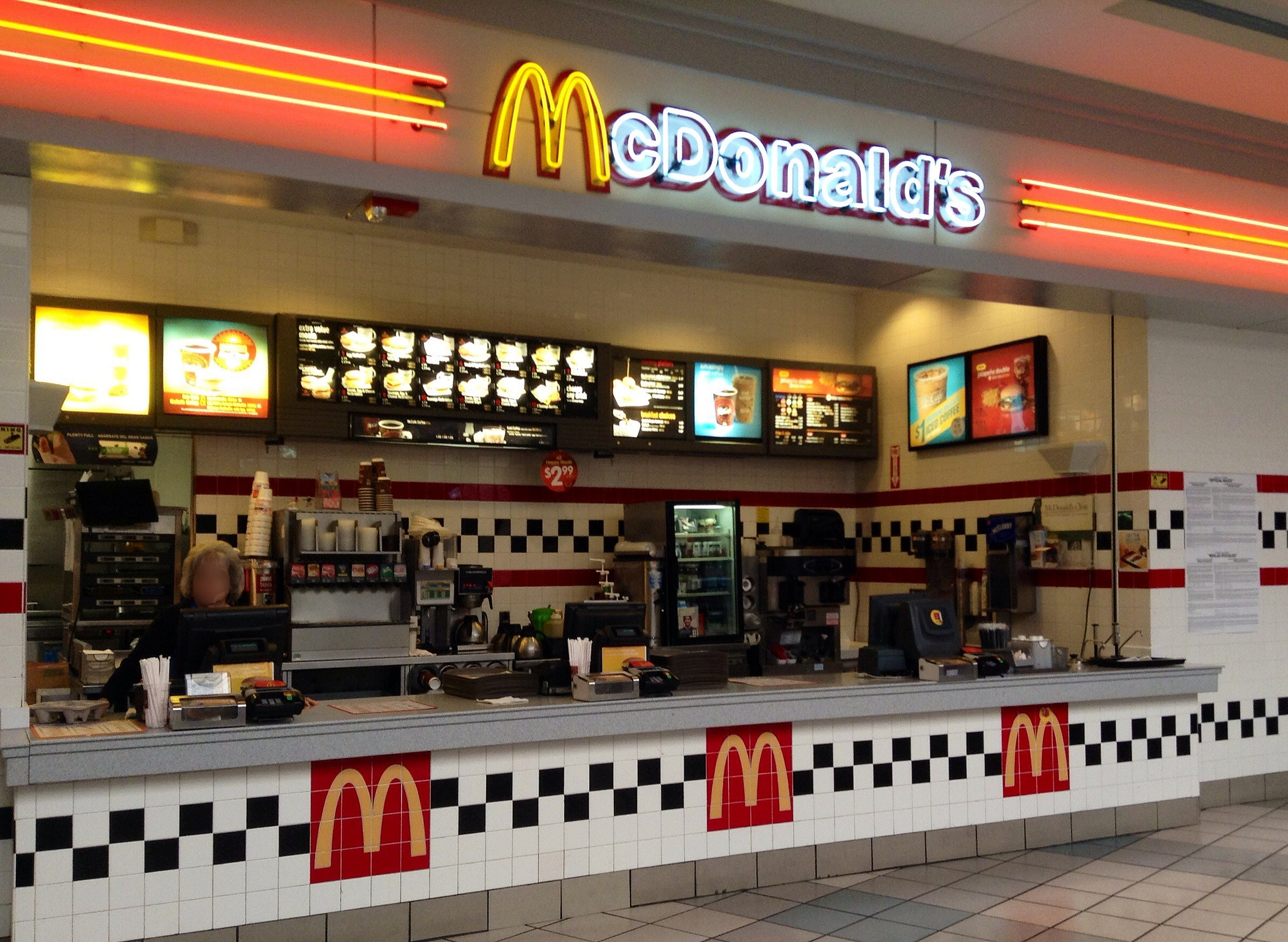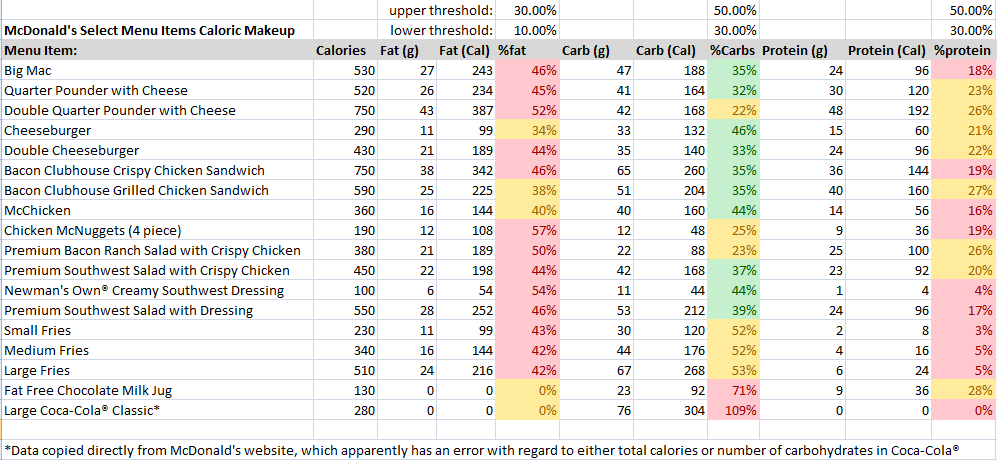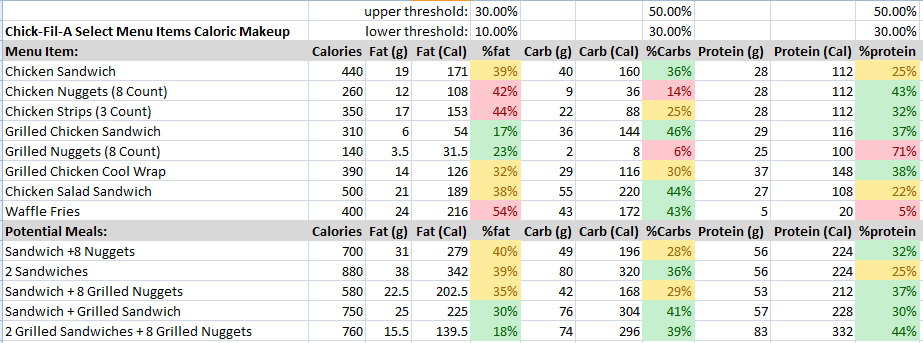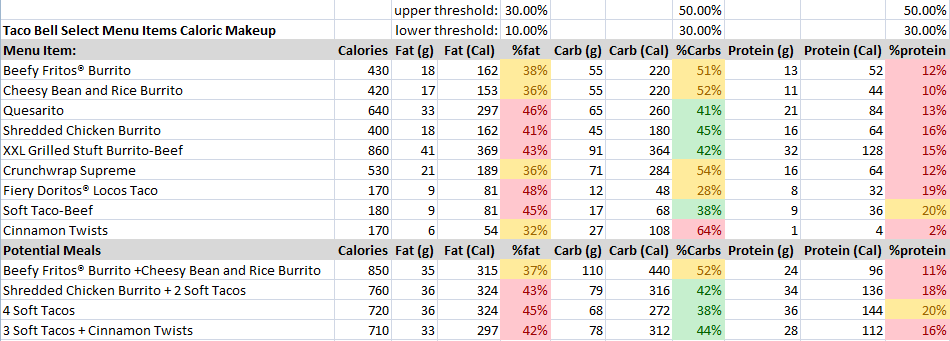In 2004, a documentary called Super Size Me came out, and changed many people's views on fast food. In it, Morgan Spurlock, a fairly average man, decided to see what happened when he ate nothing but McDonald's for a month. The results were striking: he experienced a 24 pound weight gain, lower energy, higher cholesterol, mood swings, and sexual dysfunction.
As a result of the movie, many people have demonized fast food (McDonald's in particular), and fast food companies have made many pushes for "healthier" menu items.
The problem is: the findings of Super Size Me were mostly a lie.
Since the documentary came out, many people have done some research into Morgan Spurlock's diet, and a subsequent documentary called Fat Head came out debunking many of Spurlock's claims. Here is one of the findings below on the supposed caloric intake that Spurlock had in the movie :
In Super Size Me, a nutritionist claims that Spurlock was eating over 5,000 calories a day. If one looks at the caloric levels of the menu items at McDonald's, however, and compares them with Spurlock's "rules" he sets for himself, then something doesn't add up. Even by the most liberal of measures, it's still hard to eat 5,000 calories a day getting typical meals at McDonald's.
In any case, eating several thousand calories a day more than you normally do is going to result in weight gain if you don't change your lifestyle very much, and it doesn't matter if the calories come in the form of Big Macs or salads: calories are calories.
Now, that being said, not all calories are created equal. The three basic macro-nutrients are fat, carbohydrates, and proteins. Fat contains 9 kcal per gram, where carbs and proteins each contain 4 kcal per gram. Your body needs all three, so be wary of "low fat" and "low carb" diets...they are telling you to deprive yourself of things your body needs to survive.
The simplest plan for determining macro-nutrient levels is 40/40/20, which means that 40% of your calories are from proteins, 40% from carbs, and 20% from fat. This gives you a pretty balanced caloric intake. For the average person, it's probably okay, although everyone is different. Now, the sources of the proteins, carbs, and fat can vary, and it is a hotly debated issue as to what kinds of foods are "good" and "bad" sources for these macro-nutrients, but let's not get into that.
With purely macro-nutrient levels in mind, I'll give a few suggestions that I've found from looking at the nutritional information of various fast-food establishments. I'll then give some data from McDonald's, Chick-fil-A, and Taco Bell that you can use when dining at these restaurants. Keep in mind I'm not a nutritionist, so treat this advice as a guide, not a set of rules.
Skip the Combo
The first and most obvious piece of advice is to not get a "combo" meal. Sure, it makes a lot of sense: you get an entree, probably a hamburger or sandwich of some type, some fries to munch on, and a drink to wash it down with. The problem is that fries and sodas have very few redeeming factors when it comes to nutrition.
In the data I've looked at, fries are almost entirely composed of carbs and fat (close to a 50/50 split). They are also really salty, which is probably not good. They can also add a ton of extra calories to your meal, up to 500 for a McDonald's large fry. If you don't care about carbs and fat and want a few hundred extra calories, then go for it, but just keep in mind that they aren't the best thing for you.
Drinks, however, are a bigger problem. Sodas and even fruit juice are almost entirely sugar, which most nutritionists seem to agree is the worst thing you can put in your body. It's okay to down one every now and then, but definitely something that should be avoided. Just get water: it has no calories (technically negative calories if it is cold), is necessary for survival, and proper levels of hydration can actually reduce food cravings. Sure, it isn't as tasty as a soda, but after you drink it consistently enough you come to forget what soda tastes like, and start to crave water instead.
Just Say No to Salads
I'm a firm believer in the Ron Swanson philosophy that salad is the "food that my food eats."
Now, I've eaten salads, I've even enjoyed salads, but the more I think about salads, the more I just ask myself the question "what's the point?"
People wanting to lose weight tend to flock to salads because they think of them as healthy and low-calorie. Sure, some salads are probably "healthy", depending on your definition of "healthy", but most are just delivery mechanisms for dressing. Most people know this, and tend to look for low-calorie dressings to coat their leaves with. Others don't. The result is either a monstrous pile of leaves coated with fatty dressing, cheese, and fried chicken, or a tasteless pile of leaves that makes you want to end your own life.
I also feel like lettuce is kind of over-rated as a source of nutrients. It has virtually no calories, which people may think is good, but what's the point of eating if the food has no calories? Reality check: you need calories to survive, and eating salads probably doesn't curb your appetite, it just makes you think you are being healthy so that you can justify stuffing your face with chocolate cake later and then complain about why you can't lose weight.
If you go to a fast-food restaurant, don't order a salad. It's like ordering a hamburger at a Mexican restaurant, it just doesn't make sense. If you go to McDonald's, get a hamburger, or a cheeseburger, or a Big Mac. Live a life worth living, dammit! Don't get a salad thinking you are being healthy, most of their salads have the same amount of calories and the same macronutrient makeup as a Big Mac. The choice is yours, but do you want to live, or just exist?
Nutritional Information of Various Menu Items at Fast-Food Restaurants
Below I will break down some menu items at McDonald's, Chick-fil-A, and Taco Bell. I chose McDonald's because it is the most popular fast-food restaurant in the world and it was somewhat unfairly criticized in Super Size Me. I chose Chick-Fil-A and Taco Bell because I like them.
Again, I'm not a nutritionist, and I'm also not recommending that you eat fast-food. As you will see, the macro-nutrient profiles of most fast-food menu items is skewed towards carbs and fat and away from protein, so you will have a hard time hitting a 40/40/20 protein/carb/fat macro profile eating fast-food. The foods are also probably limited in their micro-nutrients (vitamins and minerals and such), so you may be able to maintain or lose weight eating fast-food, but it probably won't be good for your body in the long run.
That being said, if fast-food is an exception to your diet, i.e. only something you eat a few times a month when travelling or just when really busy, then there's really no reason why you can't gorge for one meal. Diets are about averages, so eating a boatload of calories for one meal won't really change your body too much if the rest of your diet is in healthy moderation.
But, if you don't want to gorge too much when eating fast-food, then it's all about portion control. 2,000 Calories per day is a metric often used for the energy needs of an average person. Your specific caloric needs, however, will vary based on your weight, muscle mass, age, sex, and amount of physical activity, so don't blindly follow a 2,000 Calorie per day diet. For the sake of simplicity, I will assume that you need 2,000 Calories per day when giving my meal recommendations, and you can adjust them for your personal needs as you see fit.
If you don't eat breakfast, then you've got 1,000 Calories for lunch and 1,000 for dinner, approximately. If you eat 500 Calories for breakfast, then you've got about 750 for lunch and 750 for dinner. If you like big dinners, then maybe you've only got 500 for lunch and 1,000 for dinner. I'm going to shoot for about 750 in this illustration, and, of course, you should adjust as needed.
What to Eat at McDonald's
A great thing about all these big fast-food companies is that they make their nutritional information for all their menu items available. You can find the nutrition facts for most of McDonald's menu items here. Below I've taken a selection of the menu items that I thought were noteworthy and broke their macro-nutrients down as a percentage of the overall Calories. The green cells mean that the macro-nutrient percentage fits within +/- 10% of the recommended level, the yellow cells mean that it is between 0% and 10% outside the recommended level, and the red cells mean that it is over 10% outside the recommended level.
In looking at this data, it seems that, at least for the menu items I chose, there isn't anything at McDonald's you can get that fits a 40/40/20 macro profile within 10%. Of course, not all foods have good macro profiles, which is why it's a good idea to combine them with other foods that can help balance them out. Unfortunately, most menu items at McDonald's have too much fat and not enough protein. There are, however, many that have about the right amount of carbs, so that's something.
If you go to McDonald's and have 750 Calories to consume, then I recommend getting 3 cheeseburgers. It will break the Caloric bank a little, but the humble cheeseburger has a decent overall macro profile, is delicious, and is only 290 Calories. So, get 3 of them, eat 870 Calories, and be happy. Or get two double-cheeseburgers for 860 Calories. Or, if you are really Calorie-conscious, get a Double Quarter Pounder with Cheese for exactly 750 Calories. Get a cup of water to drink and nothing else! The Bacon Clubhouse Grilled Chicken sandwich has probably the best overall macro profile, but there is just something I don't trust about a Grilled Chicken sandwich from McDonald's, plus it only has 590 Calories, so you will have to get something else on the side for 160 Calories. You could get a four-pack of chicken McNuggets, but they have a pretty awful macro profile and will negate anything you gained from getting the grilled chicken sandwich.
As you can see, a southwest salad with the southwest dressing has 20 Calories more than a Big Mac, and about the same macro profile. I'll take the Big Mac over the salad, thank you.
What to Eat at Chick-fil-A
Chick-fil-A got something of a bad rap in the progressive community a few years ago because their CEO and founder said he didn't like gay people...but their chicken sandwiches and biscuits are pretty darn tasty so...I didn't care. Hell, he could have said that he thinks all people named "Zach" should be put to death and I would still eat there. They also do a lot of good things for communities, so there's that.
In any case, Chick-fil-A's menu is not as varied as McDonald's, at least in terms of things you would actually want to get (can't say I've ever had their chicken salad). The main decision you have to make at Chick-fil-A is do you want a sandwich or nuggets...or both? Whatever your choice, always get Polynesian sauce, it has a flavor that can't be explained.
Here is the breakdown of some of the menu items below:
What should be immediately obvious about Chick-fil-A is that there is a lot more green on the chart and a lot less red than McDonald's. This makes some sense, chicken is generally higher in protein and lower in fat than beef, so they've got that going for them.
At Chick-fil-A, you have some choices available to you: you can either be healthy and get their grilled chicken items, or slightly unhealthy and get their fried chicken items. I've never gotten their grilled chicken because, well, I like to live life to the fullest, but more power to ya if you do.
With our same 750 Calorie budget, we have some options. If you want to be healthy, you can get a full 2 grilled sandwiches and 8 grilled nuggets for 760 Calories and a near-perfect macro profile. Or you can do a hybrid approach and get a regular fried chicken sandwich and a grilled chicken sandwich for 750 Calories and a respectable macro profile.
If, however, you want to be a little bad (recommended), then get a sandwich and 8 nuggets for only 700 Calories and a somewhat decent macro profile (hey, better than McDonald's). Or get 2 sandwiches for 880 Calories. I go back and forth between these two options.
Don't get their fries. They are 500 Calories of carbs and fat, and they aren't even that good. McDonald's definitely has them beat in the fry category (in terms of taste, they are bad for you either way).
Taco Bell
Ah, Taco Bell...perhaps nothing is more synonymous with "you are going to love this in the moment and regret it later."
Taco Bell's menu is pretty extensive, so I'm going to be a little biased and just point out menu items that I like. You can find their full nutrition facts here.
The macro-nutrient makeup of the Taco Bell menu items that I selected above looks fairly similar to the profile of many McDonald's menu items...except that it's worse. Both are skewed towards fat and carbs, but the majority of these Taco Bell menu options have pretty lacking amounts of protein.
Now, the number of possible meals you can make with all the Taco Bell menu items is just astronomical, but I put together a few combinations that seemed best in the chart. Just go ahead and make your peace with the fact that eating Taco Bell is not the healthiest thing in the world. Once you've done that, the burritos go down much easier.
I normally get a few soft tacos and maybe a burrito of some sort, which is pretty good if I do say so myself, and costs like $5. If you want to break the Caloric bank a little you can get the Grilled Stuft Burrito or a Beefy Fritos Burrito and a cheesy bean and rice burrito, or a quesarito and something else (damn I love their quesaritos).
Or you can do what I normally do and get 3 beef soft tacos and some cinnamon twists. Yes, their cinnamon twists are mostly just sugar, but they are just really good and are only 170 Calories. Plus they get the taco and hot sauce taste out of your mouth. Once you've made the choice to eat at Taco Bell, the ship has pretty much sailed on "good health", so you might as well just fully commit to being bad. One silver lining is that their hot sauce has zero Calories, so...throw on as much as you want...if you don't care about sodium.
Well, there you go, it's possible to eat fast food and not change your body weight. It's even possible to eat fast food and lose weight! In fact, it's possible to eat ANY food that contains Calories and gain or lose weight! Wow! Who knew?






